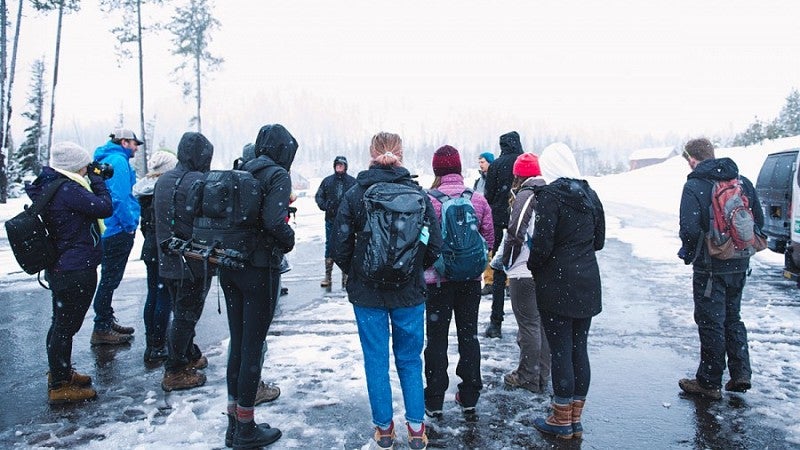Editor’s note: This student blog post is the third in a series of three written by UO School of Journalism and Communication and environmental studies students who attended a special field trip with Dennis Dimick in April. Dimick, former picture and environment editor for National Geographic and founder of Eyes on Earth, visited the SOJC to deliver the school’s 2018 combined Robert and Mabel Ruhl and Richard W. and Laurie Johnston Ruhl Lecture, “The Human Age: Our Anthropocene Conundrum.”
Story by Morgan Krakow
Photos and captions by Cheyenne Thorpe

The McKenzie River peeks out behind Douglas firs and oak trees along Oregon Highway 126. Almost unexpectedly, a rushing, bluish body appears, snaking its way alongside the road.
The first time I saw it, I was driving with my mom, completely awed by the river’s power and beauty as it came into view. My surprise stemmed from my preconceived notions of freshwater as slow and dark: the wide and muddy Missouri River of my hometown, chugging slowly against a backdrop of downtown and industry, the shallow creek where I chased frogs in my Kansas City suburb, the brown Namekagon that held my canoe during a summer camp trip in Wisconsin.
Since that first glimpse of the McKenzie, I’ve spent more time along rivers — the Deschutes, the Yellowstone, the Crooked, the Flathead, the Musselshell, the Missouri’s headwaters in central Montana, the Columbia and the Willamette. Each one has its own flow, local lore and history. Each holds a significant place within the economic and cultural development of the communities it flows through.
In many ways, rivers encapsulate the spirit of a place. Rivers are an ethos for communities across the globe. And the McKenzie is no different.
On my most recent trip up the McKenzie — a field trip with UO School of Journalism and Communication faculty and students and Dennis Dimick, former picture and environment editor for National Geographic — I reflected on of the river’s constant motion and change. It was early spring, and we started at the snow-packed Santiam Pass, melty snowflakes lining our jackets and caps. Someone pointed out that soon these flakes would flow along the McKenzie and pass through our own backyards when it joins the Willamette River. Maybe humans would extract them from the river to water a plot of farmland, or they would run off into a wetland. Maybe the onetime snowflakes will make it all the way into the Pacific Ocean after the Willamette joins the Columbia River near Portland.

We left the mountains, following the McKenzie toward Clear Lake, where the river begins its flow. Then we continued to descend in elevation to visit Redneck Organics, a farm that sits on the outskirts of the Willamette National Forest and has a channeled segment of the river flowing through it.
At each stop, my fellow students and I were reminded of the impact humans have had on this river system. Warming temperatures have led to a change in the snowpack at high elevation, where more precipitation will soon fall as rain instead of snow. The spotted owl population is still decreasing 4 percent every year because logging, fire and competition from other predatory species continue to reduce its vital habitat. These forests line much of the McKenzie’s banks and those of many of the rivers of the Pacific Northwest, reminding us of the economic importance of timber and the complexity of modern forestry management.
As a journalist, I appreciate the challenge of synthesizing the many facets of a river and the changing climate that is now part of its story. By seeking to understand all of the stakeholders and perspectives that shape the river and the lands around it, we can all better understand the values, systems and ideas that make up a place. This trip helped remind me how critical it is to highlight the interconnectedness of our environment — and how helping others understand can bring about a watershed moment.
Morgan Krakow is a senior in the UO’s Robert D. Clark Honors College, with a double major in international studies and journalism. She has worked on several student publications since high school, most recently as editor-in-chief of Ethos magazine, an independent, student-run magazine at the University of Oregon.
A senior in the UO School of Journalism and Communication, Cheyenne Thorpe focuses her studies on the impacts of visual storytelling. In 2017, she served as a photojournalist for the SOJC’s Science & Memory on the Oregon Coast and for Northwest Stories in Vietnam. This year, she is working for the SOJC’s Communications Office as a videographer and for the UO’s student-run environmental magazine Envision as the visual director. She is currently a summer photography intern for Multnomah County Communications. See more of her work at www.cheyenne.photography and on Instagram @cthorpephotos.

